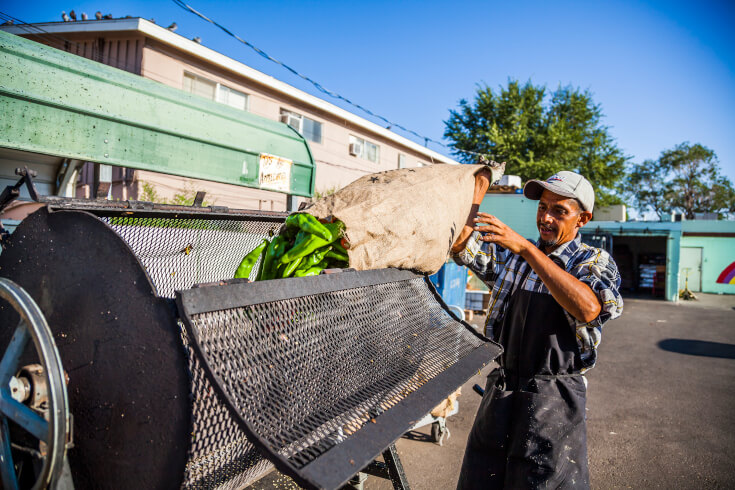A New Food Economy

How New Mexico could transition to more self sufficiency through food processing facilities.
There are few other places in the country with as much of a defined regional cuisine and foodshed as New Mexico. Whether it’s growing green chile or raising sheep, there’s a lot of farming and ranching wrapped up in New Mexico’s culture and history, and we take pride in the foods that define us. Producing those foods has been an equally huge part of our state’s economy for generations—and there’s no sign that will change anytime soon.
According to the Department of Agriculture’s Agricultural Statistics Report, the total value of New Mexico’s agriculture sector in 2018 was $3.17 billion, and the value of animals and animal products was $2.18 billion.
But despite being such a huge agricultural producer, our state tends to export most of its food products rather than process and sell them here at home. There are many reasons for this, but a major contributing factor is the high cost of bringing processing facilities into New Mexico. Currently, many farmers and ranchers have to take their products to other states to get processed, an expensive and time-consuming step—and a barrier to entry for many.
For example, New Mexico is the largest producer of pecans in the country. “But until about two years ago all our pecans had to go to Texas to get shelled,” says Kelly Egolf, the CEO and managing partner of New Mexico Fresh Foods. “We just recently got our very first pecan shelling facility here.”
Seeing disparities like this and the gaps they represent in the local food economy, Egolf started New Mexico Fresh Foods in 2019 to process food products here in New Mexico. The company is planning on opening a high-pressure food processing plant in Albuquerque later this year.
As the COVID-19 pandemic has brought many industries to a screeching halt nationwide, it has also highlighted food security and sufficiency in many communities, including New Mexico. New Mexico’s reliance on food products that are processed in and delivered from different states—or different countries—are greatly impacted by shipping delays and labor shortages. For all of us that means limits, especially as time goes on, on what’s available on our grocery store shelves.
The consequences of the pandemic are also impacting local farmers, ranchers, and producers, who are suddenly finding that their distributors can’t get them what they need, and the travel to their usual processing facilities is suddenly unsafe or unfeasible under COVID-19 conditions.
The New Mexico Fresh Foods plant will feature hiperbaric high-pressure processing (HPP) equipment that allows food companies to make their fresh food products more shelf-stable. “So, suddenly, local products have the shelf life to be sold at grocery chains, and shipped across the state and country,” Egolf says. “We believe that there will be many food innovators that will be able to use this equipment.” She notes that New Mexico has thousands of acres of old apple orchards that go mostly unharvested, and that the facility could open the door to many locally-grown apple products as just one of many examples. The plant will also offer final packaging and refrigerated storage for companies that need it.
Egolf hopes to have the plant open by January 1 of 2021, though the pandemic has hindered their momentum already and has made their plans much less concrete than they’d like. She projects that the plant will create 120 jobs in Albuquerque.
New Mexico Fresh Foods isn’t the only new development in the state’s food economy. In April, the New Mexico Economic Development Department announced it was giving a LEDA grant to High Plains Processing, a Colorado meat processing company that’s in the process of building a facility in Las Vegas, New Mexico. This will be the only beef processing plant in the whole state—a glaring absence in a place that has such a history of ranching.
“Currently, we have to drive up to Colorado once or twice a week to either pick up or deliver animals,” says Zach Withers of Polk’s Folly Farm and Butcher Shop in Cedar Crest. It’s an expensive and time-consuming task, especially for small businesses that don’t have the ability to contract out their delivery driving. This is a task that could be made much easier by the opening of the new High Plains Processing facility.
Although the pandemic has certainly slowed the process of this facility as well, they’re still planning to begin operations in the second half of 2020.
“American beef is the best in the world and New Mexico has great incentives and a really good work force. We are glad to be able to move into an existing building with good infrastructure. The community and San Miguel County are really behind what we are trying to do,” says Chip Meston, who owns High Plains Processing with his wife, Joanna.
As we move forward from this pandemic, we have an opportunity to think about how to make our state more resilient for future disasters. Both these facilities opening in New Mexico represent a step forward in New Mexico’s state sufficiency and food security, not to mention an economic advantage. By creating new jobs and helping existing producers to process, package, and sell their product locally, we’ll recover from this economic downturn even stronger than before.





